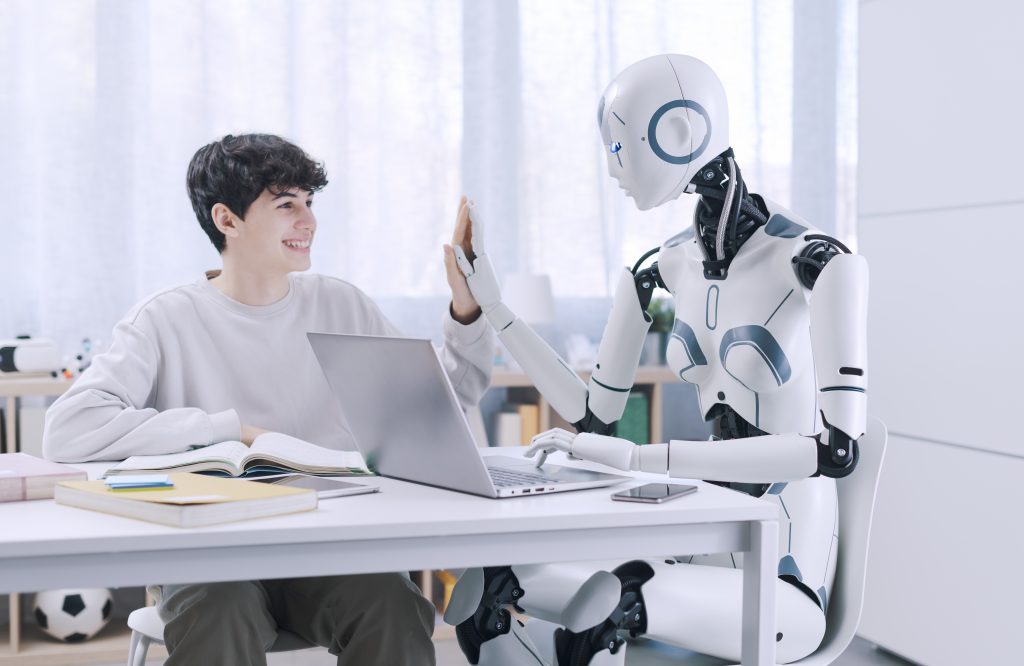Generative AI (gen AI) is already revolutionizing workplaces by accelerating—and in some cases automating—routine tasks. But what happens when we look beyond entry-level work and focus higher up the organizational chart? A recent study conducted reveals that generative AI could compress corporate hierarchies and enhance efficiency by relieving middle managers of certain coordination-related responsibilities. However, companies first need to make key decisions regarding which tasks should be automated and who stands to gain the most from these changes.
It has only been a short time—less than three years—since OpenAI released ChatGPT, yet the impact of generative AI on the workplace has been swift and significant. Activities that previously occupied large portions of employees’ workdays are now being completed faster—or even automatically.
This development has prompted researchers to examine a critical question: how might generative AI alter the nature of middle management?

A team of experts sought to explore how workers are using generative AI and what this might mean for managerial duties. Between 2022 and 2024, they analyzed data from 50,032 software developers around the globe. Half of these individuals were using GitHub Copilot—a generative AI tool that assists programmers by generating lines of code. This tool helps developers code more efficiently, resolve issues faster, and develop skills independently. The team reviewed over 2.4 million discrete actions taken within the platform, which they organized into two categories: core responsibilities (such as coding) and managerial duties.
“By studying how developers engaged with GitHub, we gained precise insights into their workflow,” they explained. “This level of detail allowed us to track shifts in task patterns and determine how generative AI was influencing job functions.”
The results showed a clear shift: those using Copilot increasingly focused on their main coding duties, spending less time on project management. Coding activities grew by 5% as a share of all actions, while project coordination tasks dropped by 10%. Two primary mechanisms seemed to explain this trend. First, the AI tool enabled developers to work with more independence, reducing their reliance on others and thereby lessening the need for coordination. Second, by making code-writing more efficient, the tool allowed developers to reallocate time toward exploration—learning new skills or experimenting.
These findings suggest that AI could support a leaner organizational hierarchy. This doesn’t mean companies will entirely eliminate middle management positions, but it does imply a reduction in such roles. For those who remain, their responsibilities are likely to evolve. Rather than focusing heavily on task coordination or serving as communication bridges between leadership and staff, managers will have more capacity for high-value contributions. For instance, they might participate more directly in technical tasks or explore innovation opportunities.

Still, realizing these benefits takes more than a simple organizational chart overhaul. If businesses hope to streamline their hierarchies—or merely reduce the project management workload for middle managers—they must tackle two essential questions: Which tasks should be automated, and who reaps the most value?
Pinpoint What to Automate
While the study concentrated on developers and their managers, any industry can potentially use generative AI to ease middle management burdens. The central challenge is identifying which responsibilities are suitable for automation and which should remain human-led.
Before implementing automation, expert advises organizations to follow their research team’s lead. They started by meticulously classifying all observed activities as either coding tasks or project management work. This type of audit can be applied to any organization, regardless of its sector. After such an analysis, leaders can better evaluate which responsibilities might transition from managers to AI systems.

Throughout their research, the team team noticed a meaningful divide between developers using AI and those who were not. Users of generative AI tended to seek less assistance from managers or colleagues. Furthermore, AI-using developers generally worked in smaller teams across nearly all task types. This shift toward smaller, more autonomous units can be an advantage for other businesses too. Monitoring how teams use AI can reveal areas where independence increases and traditional managerial oversight becomes less essential.
“In certain cases, generative AI can stand in for a supervisor, mentor, or peer,” expert notes. “Managers aren’t always available, and large group meetings aren’t always productive. With gen AI, individuals can often troubleshoot or learn without needing additional oversight.”
Identify Who Gains the Most
Another key insight from the research was that developers with lower skill levels benefited more significantly from generative AI than their highly skilled peers. These less-experienced developers tended to spend more time coding and less time coordinating, making them more receptive to AI assistance. Prior research supports this dynamic—people with less domain expertise are generally more inclined to trust and rely on AI tools.
This insight presents a notable opportunity. Instead of requiring managers to spend substantial time mentoring lower performers, companies can now leverage gen AI to help these employees self-improve. This could save managers significant time while simultaneously enhancing productivity across the team. The extra capacity might allow managers to focus on strategic contributions or innovation.

Moreover, middle managers can use this knowledge to assess their team members’ strengths and weaknesses more effectively. Are underperforming employees clear about their deliverables and the expected standards? What know-how do top performers possess that could be shared with others? With gen AI’s help, managers can guide struggling employees toward independent improvement strategies.
It’s important to note that AI isn’t only valuable for less-skilled workers. Employees at all ability levels can benefit from AI tools, regardless of the job type. Although experts’ research focused on software developers, studying how individuals of varying skill levels interact with gen AI in other fields can provide additional opportunities to refine work processes and streamline hierarchies. But without speaking directly to employees and learning how they’re applying AI tools, businesses may miss key knowledge-sharing opportunities—and fail to identify which managerial responsibilities can be offloaded to AI. “We’re going to see increased agility among AI-using companies,” an expert predicts. “That agility will lead to flatter corporate structures, enhanced productivity, and reduced reliance on traditional middle management.”
“We’re going to see increased agility among AI-using companies,” an expert predicts. “That agility will lead to flatter corporate structures, enhanced productivity, and reduced reliance on traditional middle management.”

“AI Is Shifting the Boundaries Between Associates and Managers”
A senior manager, head of Workforce Innovation at Big 4, focuses on business transformation and large-scale workforce initiatives. She shared with HBR how gen AI is reshaping job roles across levels in her organization.
Is AI contributing to a flatter hierarchy at your company?
Experts say we were already trending in that direction. The workplace is shifting to a model that values skills over titles. We’re seeing contributions assessed more on individual capabilities and impact rather than formal job levels. Since gen AI can act as a guide, creative partner, or knowledge assistant, it enables anyone to operate at a higher capacity. This is gradually dissolving the boundaries between manager and associate roles.
Does that mean associates are now performing tasks once reserved for managers?
In many cases, yes. The expectations for associate-level employees have grown significantly. Thanks to AI, we now expect associates to prepare for meetings or strategic discussions at a level that used to be required only of managers.
Can you give an example?
At the beginning of a project, we usually conduct discovery interviews with clients to understand their workflows and status. Previously, associates would gather, review, and suggest actions based on this data. Now, generative AI helps them complete this work in three hours instead of five. Those extra two hours are often reinvested into upskilling or taking on more complex assignments. High performers are using that time to handle more advanced tasks or assist with strategic elements—things previously managed by more senior staff.
Have any middle managers started performing duties that align more with executive roles?
Yes, certainly. A lot of the discussions involve creating solutions to client problems, and traditionally, we apply a standard methodology to develop a fix. Middle managers were expected to master that methodology. Today, with gen AI, we can train the tool to understand and explain those methodologies to anyone. Team members can research the process using AI and come into meetings already familiar with it. As a result, middle managers now spend less time teaching and more time executing—connecting methodologies directly to client issues.
Have middle managers resisted this shift?
We’ve made meaningful progress, but yes, some resistance still exists. We try to foster an environment where people feel safe expressing their concerns. This creates space for open conversations. We tell hesitant managers that there are still vital parts of their role that AI can’t replicate. For instance, their ability to interpret client feedback, guide discussions, and uncover unspoken needs remains irreplaceable. These are highly human tasks—ones that AI isn’t equipped to handle yet. Ironically, these conversations are now possible because AI has relieved managers of other tasks that used to consume their time.
Conclusion
As AI adoption accelerates, organizations will gain greater agility in how they operate and innovate. This shift is set to flatten traditional corporate hierarchies, making decision-making faster and more collaborative. Enhanced productivity will follow as teams leverage AI tools to streamline processes and optimize performance. With these changes, the role of traditional middle management may evolve—or become less central. Businesses that embrace this transformation early are likely to lead the future of work.
